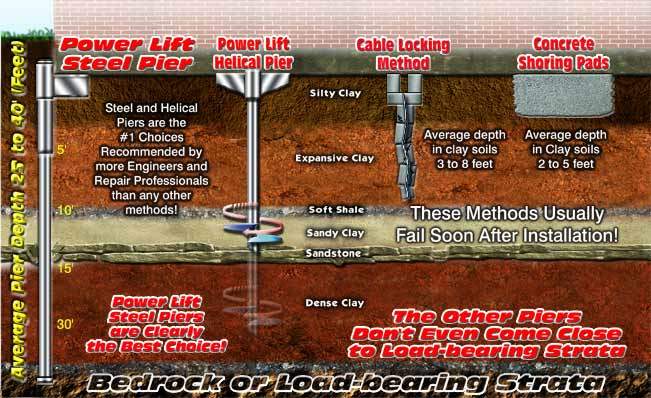PowerLift Advantages
The PowerLift advantage lies in its unmatched reliability and durability. Our steel piers provide a long-lasting solution, ensuring the stability of your foundation for years to come. Engineered with excellence, PowerLift Steel and Helical Piers are the top choices recommended by engineers and repair professionals, proving their effectiveness in various soil conditions. With a superior load-bearing capacity, our steel piers are ideal for both residential and commercial applications. Additionally, the installation process is quick and causes minimal disruption to your property, allowing you to resume normal activities faster. This combination of reliability, engineering excellence, superior capacity, and minimal disruption exemplifies the PowerLift advantage.
Don’t be misled…about which system works best in unstable clay soils.
Advantages of Powerlift Steel Piers
- Driven to Bedrock: PowerLift Steel Piers are driven to bedrock or load-bearing strata, providing unmatched long-term performance.
- Penetrates Unstable Soil: Unlike other systems, our steel piers penetrate unstable soil zones to depths unaffected by seasonal moisture changes, ensuring stability year-round.
- Proven Method: Our steel piers are designed for easy installation, achieving maximum elevation, cosmetic recovery, and lifetime performance.
- Advanced Lifting System: PowerLift utilizes the most advanced synchronized lifting system available. This minimizes stress during the lifting process and ensures maximum crack closure.
- Minimal Landscape Damage: The installation of PowerLift Steel Piers requires minimal landscape damage, preserving the beauty of your property.

Disadvantages of Pressed Piles
- Insufficient Penetration: Pressed piles do not penetrate unstable clay soils deeply enough and rarely provide a long-term fix.
- Seasonal Movement: These piles move with seasonal moisture changes, leading to recurring foundation issues shortly after installation.
- Weak Construction: Pressed pile sections are often made of non-reinforced concrete, which can break during installation.
- Ineffective Cable: The cable used in pressed piles makes no significant difference in foundation support.
- Engineer Disapproval: Engineers generally do not favor the pressed pile system, especially in expansive clay soils, due to its minimal load-carrying capacity.
- Short-Lived Solutions: Methods like Cable Locking and Concrete Shoring Pads usually fail shortly after installation, leading to more repairs and costs.
Steel and Helical Piers are the #1 choices recommended by more engineers and repair professionals than any other methods!
Cable Locking Methods and Concrete Shoring Pads usually fail shortly after installation.
PowerLift Steel Piers are clearly the best choice; the other piers don’t even come close to load-bearing strata.


